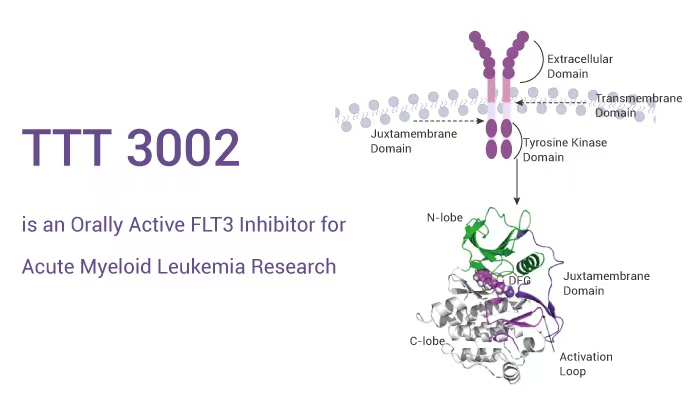TTT-3002, a tyrosine kinase inhibitor is one of the most potent FLT3 inhibitors. FLT3 (Fms-like tyrosine kinase 3, CD135) is a cytokine receptor that belongs to the receptor tyrosine kinase class III. FLT3 is the receptor for the cytokine Flt3 ligand (FLT3L). FLT-3 exists on the surface of many hematopoietic progenitor cells. Signaling of FLT3 is important for the normal development of hematopoietic stem cells and progenitor cells. The FLT3 gene is one of the most frequently mutated genes in acute myeloid leukemia (AML). Besides, high levels of wild-type FLT3 for blast cells of some AML patients without FLT3 mutations. Therefore, FLT3 plays a role in cell survival, proliferation, and differentiation. FLT3 is important for lymphocyte (B cell and T cell) development, but not for the development of other blood cells.
Genomic investigations of AML have demonstrated that several genes are recurrently mutated, leading to new genomic classifications, predictive biomarkers, and new therapeutic targets. Mutations of the FLT3 gene occur in approximately 30% of all AML cases. Besides, FLT3-ITD is a common driver mutation that presents with a high leukemic burden. The FLT3 mutation in the tyrosine kinase domain (FLT3-TKD) has a lower incidence in AML.

TTT 3002 is a potent and orally active FLT3 inhibitor.
TTT 3002 shows picomolar IC50s for autophosphorylation of FLT3/ITD and FLT3/PM mutations. Besides, TTT-3002 significantly improves the survival and tumor burden of mice in several FLT3/ITD transplantation models via oral dosing. Further studies reveal that TTT-3002 is active against FLT3-expressing blasts from primary patient samples while showing minimal toxicity to normal BM mononuclear cells and CD34+ progenitors. Therefore, TTT-3002 exhibits potential as a promising new FLT3 tyrosine kinase inhibitor in the research of FLT3-mutant AML.
All in all, TTT 3002 is a potent and orally active FLT3 inhibitor that has the potential for AML research.
References:
[1]. Daver N, et, al. Leukemia. 2019 Feb;33(2):299-312.
[2]. Ma H, et, al. Blood. 2014 Mar 6;123(10):1525-34.